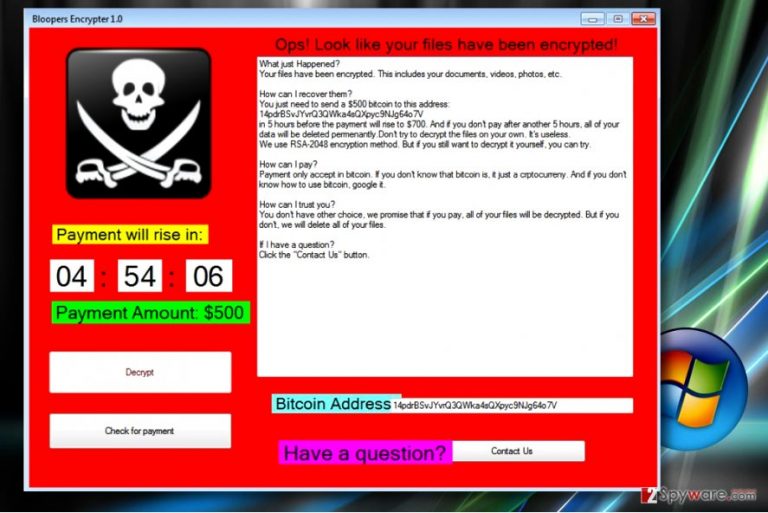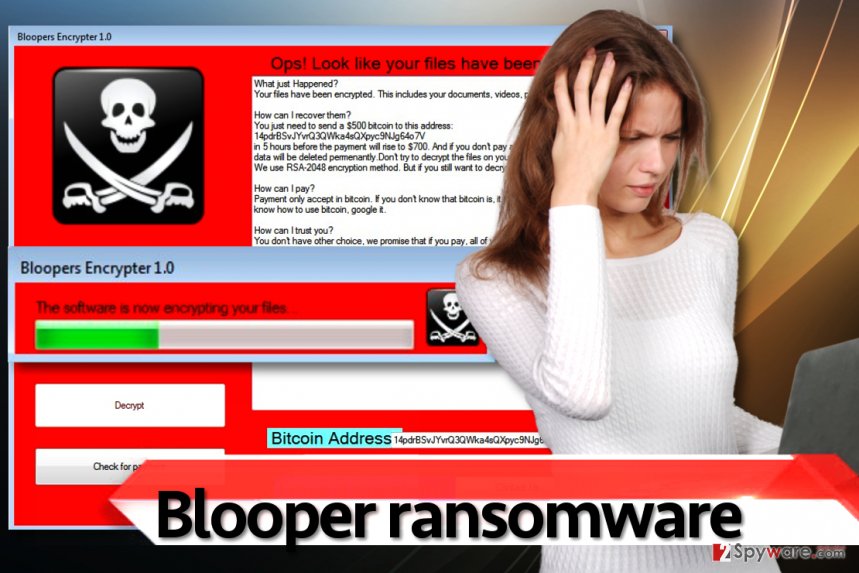Blooper ransomware / virus (Free Instructions) - Recovery Instructions Included
Blooper virus Removal Guide
What is Blooper ransomware virus?
Do not pay the ransom if your PC was compromised by Blooper ransomware virus – it doesn’t encode data
Blooper virus is a fake ransomware that doesn’t encrypt files[1]. Despite that, the ransomware still pretends to be dangerous and demands a ransom from the victim. Once installed on the target system, the malicious program launches a program window called Bloopers Encrypter 1.0, which opens a pop-up with a progress bar on it and a line that says “The software is now encrypting your files…” That is, in fact, an absolute lie because the ransomware doesn’t encrypt anything. The ransom note that is displayed by the Encrypter obviously copies WannaCry’s GUI, and also shows a countdown clock. The virus demands $500, which is quite a large ransom price if compared to sums asked by other ransomware viruses. If this ransomware managed to compromise your computer, follow instructions provided at the end of this article to remove Blooper ransomware from the system correctly. We will ask you to use a professional ransomware removal tool to eliminate the virus safely. If you do not have anti-spyware or anti-malware software to do it for you, you might want to use FortectIntego software that we recommend.

Although this ransomware is simply coded by amateur programmers, you should not underestimate the power of ransomware. Viruses like Cerber or Locky still wreak havoc on a global scale and computer security experts are hopeless to find a way to help victims. After removing the ransomware, you should get a portable data storage device such as hard drive or high-capacity USB and export created data copies to it. Learn more about data backups.
Distribution of ransomware programs
Developers of poor quality ransomware programs tend to employ techniques used by sophisticated ransomware developers. The technology that helps both inexperienced and advanced ransomware developers spread their malicious programs is the same and to be honest, is quite basic. They create convincing messages and rename the malicious file as an invoice, document, resume, subpoena, or another important-looking document[2]. Then they send out such letters to thousands of computer users worldwide. Once someone gets on the hook and opens the email attachment, their computer gets infected with ransomware. For this reason, you should never open emails sent by suspicious individuals. Keep in mind that ransomware creators tend to use well-known company names and logos in their letters to make them appear more legitimate and trustworthy. To spot a fraud, we suggest looking at sender’s email address.

Blooper ransomware removal guidelines
Security experts recommend using up-to-date anti-malware programs for Bloopers Encryptor removal, as it is the easiest and fastest way to kill the malicious program and eliminate its remains. If you do not have such security software, we suggest using one of the programs we recommend. You can find a list of them below the article, and we also suggest you check out their reviews provided on the Software page. Before you begin, reboot your PC using instructions provided below so that your security software could remove Blooper virus with ease.
Getting rid of Blooper virus. Follow these steps
Manual removal using Safe Mode
Remove Bloopers after rebooting the system into Safe Mode with Networking. The following instructions will help you to do it.
Important! →
Manual removal guide might be too complicated for regular computer users. It requires advanced IT knowledge to be performed correctly (if vital system files are removed or damaged, it might result in full Windows compromise), and it also might take hours to complete. Therefore, we highly advise using the automatic method provided above instead.
Step 1. Access Safe Mode with Networking
Manual malware removal should be best performed in the Safe Mode environment.
Windows 7 / Vista / XP
- Click Start > Shutdown > Restart > OK.
- When your computer becomes active, start pressing F8 button (if that does not work, try F2, F12, Del, etc. – it all depends on your motherboard model) multiple times until you see the Advanced Boot Options window.
- Select Safe Mode with Networking from the list.

Windows 10 / Windows 8
- Right-click on Start button and select Settings.

- Scroll down to pick Update & Security.

- On the left side of the window, pick Recovery.
- Now scroll down to find Advanced Startup section.
- Click Restart now.

- Select Troubleshoot.

- Go to Advanced options.

- Select Startup Settings.

- Press Restart.
- Now press 5 or click 5) Enable Safe Mode with Networking.

Step 2. Shut down suspicious processes
Windows Task Manager is a useful tool that shows all the processes running in the background. If malware is running a process, you need to shut it down:
- Press Ctrl + Shift + Esc on your keyboard to open Windows Task Manager.
- Click on More details.

- Scroll down to Background processes section, and look for anything suspicious.
- Right-click and select Open file location.

- Go back to the process, right-click and pick End Task.

- Delete the contents of the malicious folder.
Step 3. Check program Startup
- Press Ctrl + Shift + Esc on your keyboard to open Windows Task Manager.
- Go to Startup tab.
- Right-click on the suspicious program and pick Disable.

Step 4. Delete virus files
Malware-related files can be found in various places within your computer. Here are instructions that could help you find them:
- Type in Disk Cleanup in Windows search and press Enter.

- Select the drive you want to clean (C: is your main drive by default and is likely to be the one that has malicious files in).
- Scroll through the Files to delete list and select the following:
Temporary Internet Files
Downloads
Recycle Bin
Temporary files - Pick Clean up system files.

- You can also look for other malicious files hidden in the following folders (type these entries in Windows Search and press Enter):
%AppData%
%LocalAppData%
%ProgramData%
%WinDir%
After you are finished, reboot the PC in normal mode.
Remove Blooper using System Restore
-
Step 1: Reboot your computer to Safe Mode with Command Prompt
Windows 7 / Vista / XP- Click Start → Shutdown → Restart → OK.
- When your computer becomes active, start pressing F8 multiple times until you see the Advanced Boot Options window.
-
Select Command Prompt from the list

Windows 10 / Windows 8- Press the Power button at the Windows login screen. Now press and hold Shift, which is on your keyboard, and click Restart..
- Now select Troubleshoot → Advanced options → Startup Settings and finally press Restart.
-
Once your computer becomes active, select Enable Safe Mode with Command Prompt in Startup Settings window.

-
Step 2: Restore your system files and settings
-
Once the Command Prompt window shows up, enter cd restore and click Enter.

-
Now type rstrui.exe and press Enter again..

-
When a new window shows up, click Next and select your restore point that is prior the infiltration of Blooper. After doing that, click Next.


-
Now click Yes to start system restore.

-
Once the Command Prompt window shows up, enter cd restore and click Enter.
Bonus: Recover your data
Guide which is presented above is supposed to help you remove Blooper from your computer. To recover your encrypted files, we recommend using a detailed guide prepared by 2-spyware.com security experts.There is no need to search for Bloopers Encryptor 1.0 decryption tool because the ransomware doesn’t touch data stored on the computers that it attacks.
If your files are encrypted by Blooper, you can use several methods to restore them:
Finally, you should always think about the protection of crypto-ransomwares. In order to protect your computer from Blooper and other ransomwares, use a reputable anti-spyware, such as FortectIntego, SpyHunter 5Combo Cleaner or Malwarebytes
How to prevent from getting ransomware
Choose a proper web browser and improve your safety with a VPN tool
Online spying has got momentum in recent years and people are getting more and more interested in how to protect their privacy online. One of the basic means to add a layer of security – choose the most private and secure web browser. Although web browsers can't grant full privacy protection and security, some of them are much better at sandboxing, HTTPS upgrading, active content blocking, tracking blocking, phishing protection, and similar privacy-oriented features. However, if you want true anonymity, we suggest you employ a powerful Private Internet Access VPN – it can encrypt all the traffic that comes and goes out of your computer, preventing tracking completely.
Lost your files? Use data recovery software
While some files located on any computer are replaceable or useless, others can be extremely valuable. Family photos, work documents, school projects – these are types of files that we don't want to lose. Unfortunately, there are many ways how unexpected data loss can occur: power cuts, Blue Screen of Death errors, hardware failures, crypto-malware attack, or even accidental deletion.
To ensure that all the files remain intact, you should prepare regular data backups. You can choose cloud-based or physical copies you could restore from later in case of a disaster. If your backups were lost as well or you never bothered to prepare any, Data Recovery Pro can be your only hope to retrieve your invaluable files.
- ^ Lee Mathews. Fake Ransomware Attacks Are Tricking Businesses Into Paying. Forbes. Global Media Company that focuses on Business, Investing, Technology, Entrepreneurship, Leadership, and Lifestyle.
- ^ Olivia Morelli. How to identify an email infected with a virus?. 2-Spyware. Fighting against Spyware.







